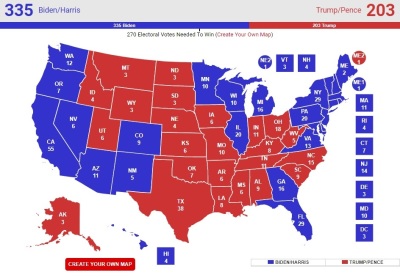Conservative values won big across America, except in contested swing states

The 2020 election revealed many interesting trends. Most notably, it revealed a number of unexpected conservative victories in federal and state elections. From the suburbs of Miami, Los Angeles, and Cincinnati to key races in Iowa and Montana, Republicans held onto key seats or made substantial gains despite millions of dollars in spending by Democrats. Yet despite these positive results, with ample opportunity to win similar races in Georgia, Michigan, Pennsylvania, and Nevada, Republicans came up short in these states. What explains this?
One of the biggest headlines from the 2020 election was President Donald Trump’s increased number of votes in major urban areas across the country, including substantial gains among the Latino community, especially in Florida. President Trump improved his percentage of the vote from 2016 in Chicago, Cleveland, Buffalo, Toledo, and even Portland and Seattle. These gains propelled President Trump to capturing north of 73 million votes nationwide, even beating President Obama’s record-setting popular vote total in 2008.
Republican candidates down ballot also had several major victories:
- Florida – Republicans flipped two U.S. House seats and made gains in the state legislature.
- Iowa – Joni Ernst won her tightly contested Senate race and Republicans picked up one and potentially two U.S. House seats.
- New Hampshire – Republicans lost competitive U.S. House races but flipped both state legislative chambers.
- Montana – Republicans held onto the U.S. Senate and House seats and flipped the Governorship.
- Texas – John Cornyn won his Senate race, and Republicans kept control of both state legislative chambers despite aggressive Democrat challenges.
- California and New York – Republicans have flipped at least one seat in each state and are on track to take back several more.
Republicans outperformed expectations in nearly every state, except the key battlegrounds that continue to have election integrity questions and will ultimately decide the final outcome of the electoral college.
There were very similar opportunities for Republican success in down-ballot federal and state races; however, they all came up short in these states.
- Arizona – Incumbent Senator Martha McSally lost her race, and Republicans failed to pick up either competitive U.S. House seats outside of Phoenix.
- Georgia – Both Sen. David Perdue and Sen. Kelly Loeffler failed to secure 50 percent of the votes, triggering runoff elections. Also, Republicans failed to pick-up a competitive U.S. House seat in the Atlanta suburbs and lost a nearby seat, the only Democrat pickup not caused by redistricting.
- Michigan – John James failed to unseat incumbent Sen. Gary Peters in a very close race and Republicans failed to pick up either of the two competitive U.S. House seats covering Oakland and Wayne counties outside of Detroit.
- Nevada – Republicans had very strong challengers in two U.S. House seats just outside of Las Vegas, but both came up short to the Democrat incumbents.
- Pennsylvania – Republicans held two competitive U.S. House Seats. However, they failed to pick off any of the three vulnerable Democrats in districts outside the major population centers of Allentown, Pittsburgh, and Scranton.
The geographic and demographic analysis of these key states reveals a lot. Urban and suburban districts in regions across the country turned favorably for Republicans, causing House districts to flip and President Trump to secure key swing states like Florida, Iowa, and Ohio. Having campaigned on law and order in response to the civil unrest throughout the summer, it makes sense why Republicans saw their prospects improve in these areas. However it is odd that these gains happened nearly everywhere in the country except for the key battlegrounds states, especially when President Trump campaigned almost exclusively in these states in the final days. National Review did address outliers for Joe Biden’s performance in several major cities, but no piece has fully captured how Trump performed compared to his 2016 totals and the impact on down ballot races in key urban and suburban centers.
One answer may be that President Trump’s message just did not resonate with the swing voters in these key battlegrounds or that there was a much stronger anti-Trump sentiment that turned out for Biden. That may be true to some degree. Yet why did geographically and demographically-similar cities and regions swing even more favorably for President Trump? The rust belt cities of Buffalo, Cleveland, Toledo, Chicago, and Gary, Indiana saw President Trump improve his vote totals, and in some cases saw Biden lose support compared to past Democrat presidential candidates. Compare those cities to Pittsburgh and Milwaukee, where Joe Biden beat Barack Obama’s unprecedented totals from 2008 and Trump underperformed, even losing support in the blue collar pro-coal, pro-steel city of Pittsburgh. When we compare them, something is amiss.
Another theory is that conservative values are gaining traction in unlikely areas, but voters just did not like Trump and his personality and so voted against him. However, if that were the case, then it would have been likely that at least one U.S. Senate or House seat would have gone in Republicans’ favor in either Arizona, Georgia, Michigan, or Pennsylvania. Instead, Democrats won nearly every close race.
It is not clear what this contrast between the presidential results and the down ballot races in key swings states means, but it certainly exists. If voter fraud were occurring, that could help explain it. There continue to be allegations of targeted voter fraud in these key swing states; allegations are currently being resolved by courts and state legislatures.
Whatever the ultimate explanation, these seemingly strange outcomes in down ballot races deserve to be analyzed and explained.
Connor Semelsberger is Legislative Assistant at Family Research Council.



























